Effective Communication Skills in Business: SHDE Report
VerifiedAdded on 2021/02/20
|11
|3398
|25
Report
AI Summary
This report analyzes communication skills within a business context, using SHDE, an electrical supplier, as a case study. It examines the communication process, identifying elements such as sender, message, encoding, media, decoding, receiver, and feedback, while also exploring common barriers like lack of planning, semantic problems, and cultural differences. The report suggests internal communication methods, including telephone, face-to-face discussions, notice boards, and email, to improve organizational efficiency. It further addresses how organizations portray themselves through communication, emphasizing formal communication channels and regular meetings to enhance customer satisfaction and business performance. The report also covers legal and ethical considerations in information communication, along with an evaluation of verbal and non-verbal communication's effectiveness. Finally, it assesses oral presentation skills and written communication, including the impact of technology, providing insights into effective communication strategies for business success.
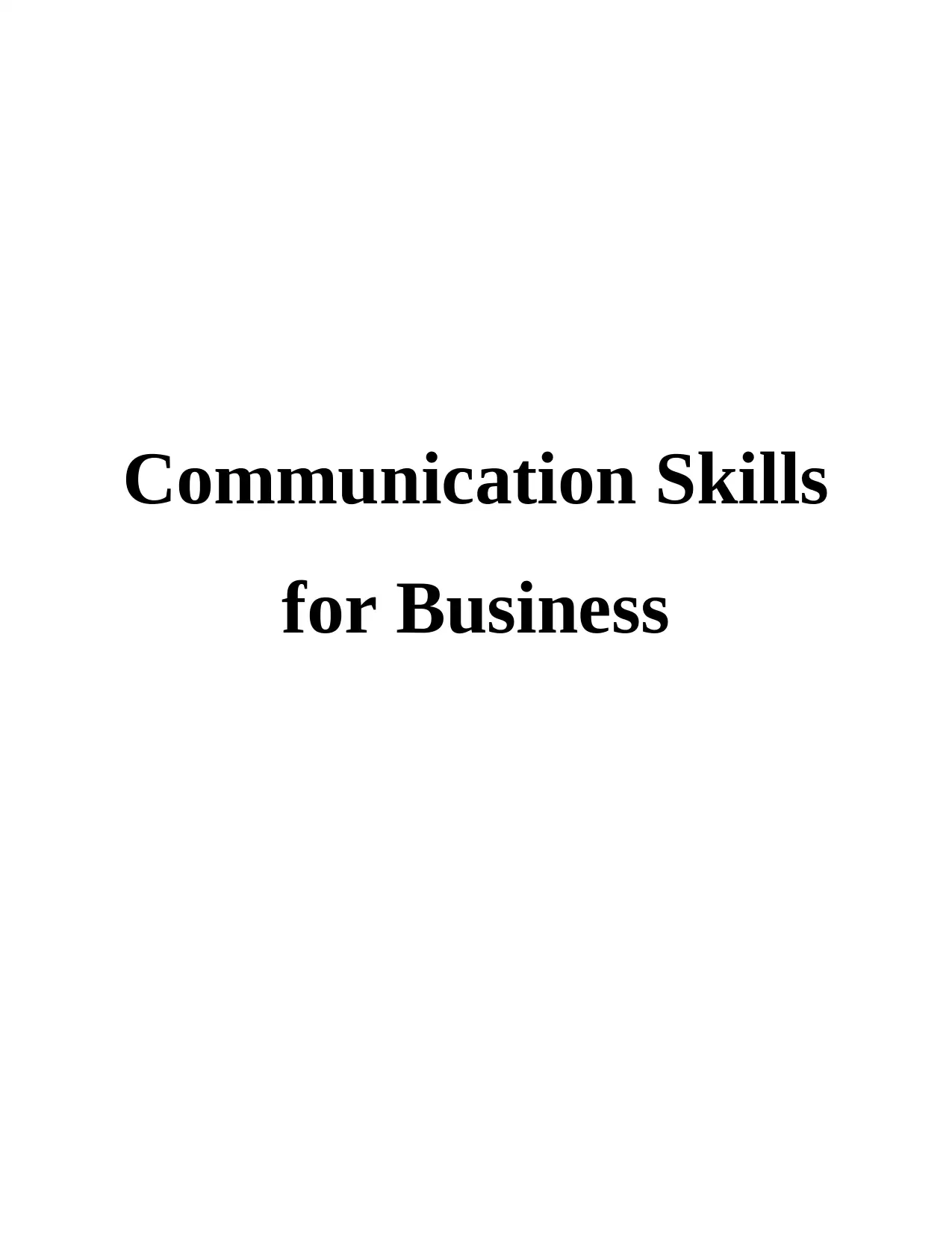
Communication Skills
for Business
for Business
Paraphrase This Document
Need a fresh take? Get an instant paraphrase of this document with our AI Paraphraser
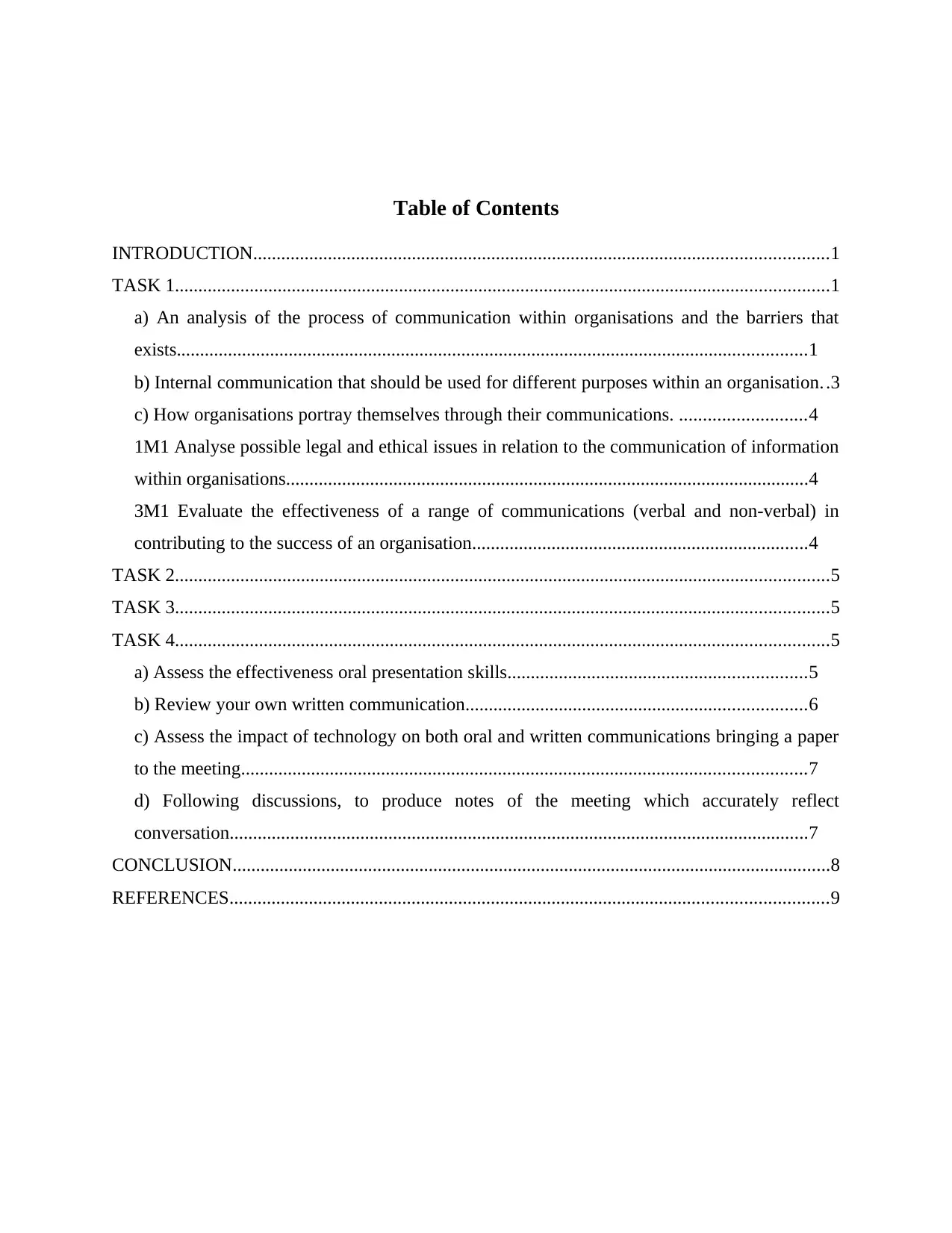
Table of Contents
INTRODUCTION...........................................................................................................................1
TASK 1............................................................................................................................................1
a) An analysis of the process of communication within organisations and the barriers that
exists.......................................................................................................................................1
b) Internal communication that should be used for different purposes within an organisation. .3
c) How organisations portray themselves through their communications. ...........................4
1M1 Analyse possible legal and ethical issues in relation to the communication of information
within organisations................................................................................................................4
3M1 Evaluate the effectiveness of a range of communications (verbal and non-verbal) in
contributing to the success of an organisation........................................................................4
TASK 2............................................................................................................................................5
TASK 3............................................................................................................................................5
TASK 4............................................................................................................................................5
a) Assess the effectiveness oral presentation skills................................................................5
b) Review your own written communication.........................................................................6
c) Assess the impact of technology on both oral and written communications bringing a paper
to the meeting.........................................................................................................................7
d) Following discussions, to produce notes of the meeting which accurately reflect
conversation............................................................................................................................7
CONCLUSION................................................................................................................................8
REFERENCES................................................................................................................................9
INTRODUCTION...........................................................................................................................1
TASK 1............................................................................................................................................1
a) An analysis of the process of communication within organisations and the barriers that
exists.......................................................................................................................................1
b) Internal communication that should be used for different purposes within an organisation. .3
c) How organisations portray themselves through their communications. ...........................4
1M1 Analyse possible legal and ethical issues in relation to the communication of information
within organisations................................................................................................................4
3M1 Evaluate the effectiveness of a range of communications (verbal and non-verbal) in
contributing to the success of an organisation........................................................................4
TASK 2............................................................................................................................................5
TASK 3............................................................................................................................................5
TASK 4............................................................................................................................................5
a) Assess the effectiveness oral presentation skills................................................................5
b) Review your own written communication.........................................................................6
c) Assess the impact of technology on both oral and written communications bringing a paper
to the meeting.........................................................................................................................7
d) Following discussions, to produce notes of the meeting which accurately reflect
conversation............................................................................................................................7
CONCLUSION................................................................................................................................8
REFERENCES................................................................................................................................9
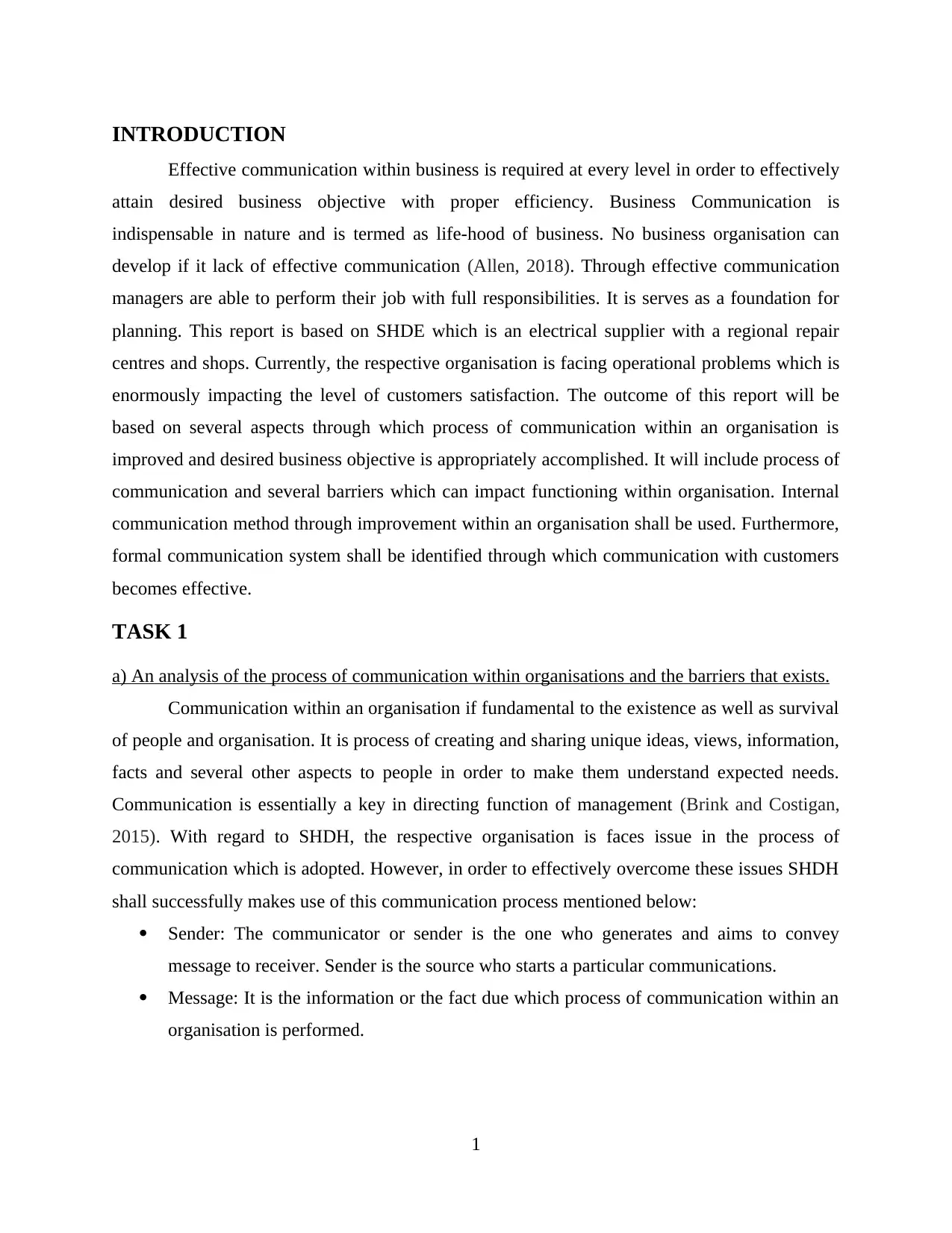
INTRODUCTION
Effective communication within business is required at every level in order to effectively
attain desired business objective with proper efficiency. Business Communication is
indispensable in nature and is termed as life-hood of business. No business organisation can
develop if it lack of effective communication (Allen, 2018). Through effective communication
managers are able to perform their job with full responsibilities. It is serves as a foundation for
planning. This report is based on SHDE which is an electrical supplier with a regional repair
centres and shops. Currently, the respective organisation is facing operational problems which is
enormously impacting the level of customers satisfaction. The outcome of this report will be
based on several aspects through which process of communication within an organisation is
improved and desired business objective is appropriately accomplished. It will include process of
communication and several barriers which can impact functioning within organisation. Internal
communication method through improvement within an organisation shall be used. Furthermore,
formal communication system shall be identified through which communication with customers
becomes effective.
TASK 1
a) An analysis of the process of communication within organisations and the barriers that exists.
Communication within an organisation if fundamental to the existence as well as survival
of people and organisation. It is process of creating and sharing unique ideas, views, information,
facts and several other aspects to people in order to make them understand expected needs.
Communication is essentially a key in directing function of management (Brink and Costigan,
2015). With regard to SHDH, the respective organisation is faces issue in the process of
communication which is adopted. However, in order to effectively overcome these issues SHDH
shall successfully makes use of this communication process mentioned below:
Sender: The communicator or sender is the one who generates and aims to convey
message to receiver. Sender is the source who starts a particular communications.
Message: It is the information or the fact due which process of communication within an
organisation is performed.
1
Effective communication within business is required at every level in order to effectively
attain desired business objective with proper efficiency. Business Communication is
indispensable in nature and is termed as life-hood of business. No business organisation can
develop if it lack of effective communication (Allen, 2018). Through effective communication
managers are able to perform their job with full responsibilities. It is serves as a foundation for
planning. This report is based on SHDE which is an electrical supplier with a regional repair
centres and shops. Currently, the respective organisation is facing operational problems which is
enormously impacting the level of customers satisfaction. The outcome of this report will be
based on several aspects through which process of communication within an organisation is
improved and desired business objective is appropriately accomplished. It will include process of
communication and several barriers which can impact functioning within organisation. Internal
communication method through improvement within an organisation shall be used. Furthermore,
formal communication system shall be identified through which communication with customers
becomes effective.
TASK 1
a) An analysis of the process of communication within organisations and the barriers that exists.
Communication within an organisation if fundamental to the existence as well as survival
of people and organisation. It is process of creating and sharing unique ideas, views, information,
facts and several other aspects to people in order to make them understand expected needs.
Communication is essentially a key in directing function of management (Brink and Costigan,
2015). With regard to SHDH, the respective organisation is faces issue in the process of
communication which is adopted. However, in order to effectively overcome these issues SHDH
shall successfully makes use of this communication process mentioned below:
Sender: The communicator or sender is the one who generates and aims to convey
message to receiver. Sender is the source who starts a particular communications.
Message: It is the information or the fact due which process of communication within an
organisation is performed.
1
⊘ This is a preview!⊘
Do you want full access?
Subscribe today to unlock all pages.

Trusted by 1+ million students worldwide
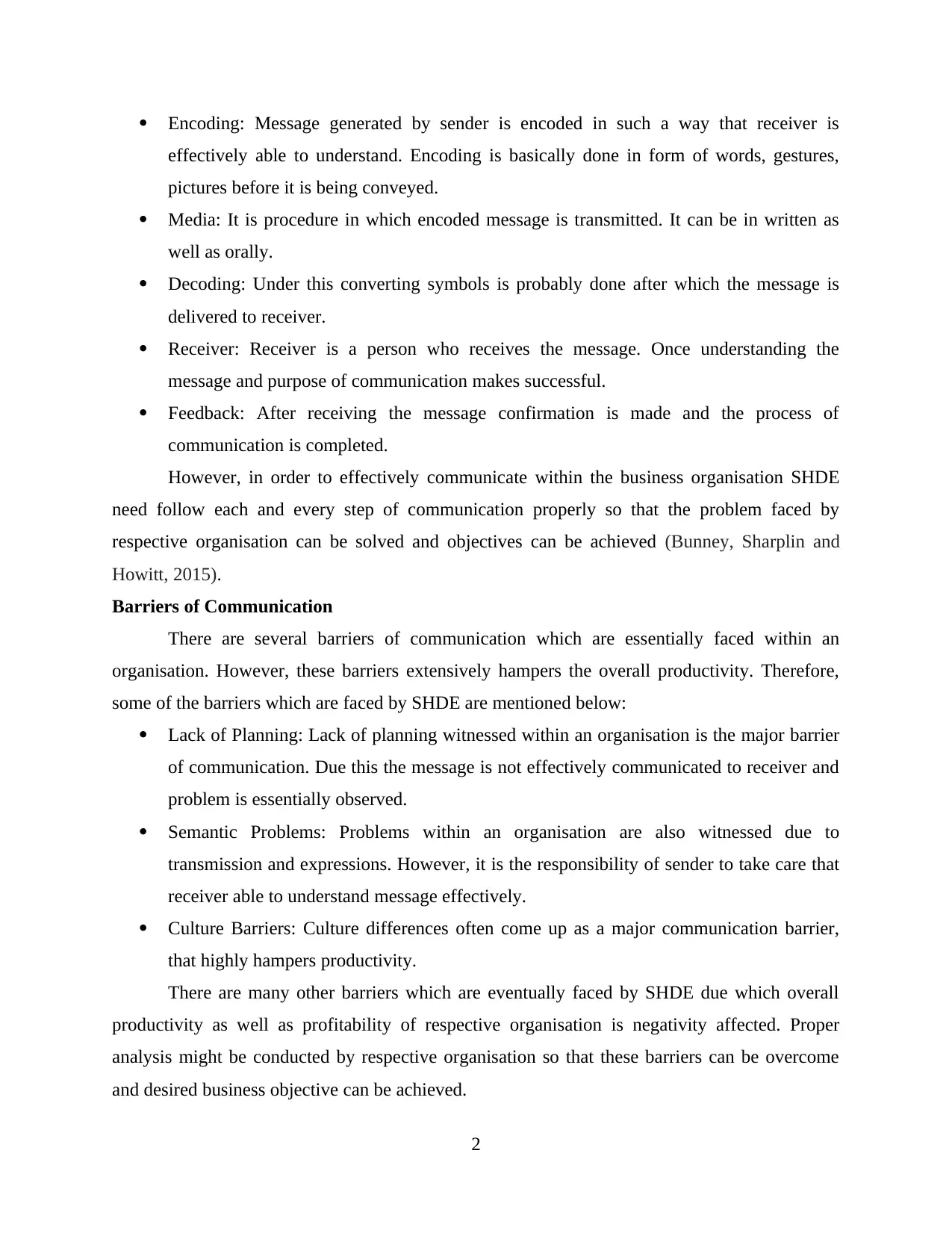
Encoding: Message generated by sender is encoded in such a way that receiver is
effectively able to understand. Encoding is basically done in form of words, gestures,
pictures before it is being conveyed.
Media: It is procedure in which encoded message is transmitted. It can be in written as
well as orally.
Decoding: Under this converting symbols is probably done after which the message is
delivered to receiver.
Receiver: Receiver is a person who receives the message. Once understanding the
message and purpose of communication makes successful.
Feedback: After receiving the message confirmation is made and the process of
communication is completed.
However, in order to effectively communicate within the business organisation SHDE
need follow each and every step of communication properly so that the problem faced by
respective organisation can be solved and objectives can be achieved (Bunney, Sharplin and
Howitt, 2015).
Barriers of Communication
There are several barriers of communication which are essentially faced within an
organisation. However, these barriers extensively hampers the overall productivity. Therefore,
some of the barriers which are faced by SHDE are mentioned below:
Lack of Planning: Lack of planning witnessed within an organisation is the major barrier
of communication. Due this the message is not effectively communicated to receiver and
problem is essentially observed.
Semantic Problems: Problems within an organisation are also witnessed due to
transmission and expressions. However, it is the responsibility of sender to take care that
receiver able to understand message effectively.
Culture Barriers: Culture differences often come up as a major communication barrier,
that highly hampers productivity.
There are many other barriers which are eventually faced by SHDE due which overall
productivity as well as profitability of respective organisation is negativity affected. Proper
analysis might be conducted by respective organisation so that these barriers can be overcome
and desired business objective can be achieved.
2
effectively able to understand. Encoding is basically done in form of words, gestures,
pictures before it is being conveyed.
Media: It is procedure in which encoded message is transmitted. It can be in written as
well as orally.
Decoding: Under this converting symbols is probably done after which the message is
delivered to receiver.
Receiver: Receiver is a person who receives the message. Once understanding the
message and purpose of communication makes successful.
Feedback: After receiving the message confirmation is made and the process of
communication is completed.
However, in order to effectively communicate within the business organisation SHDE
need follow each and every step of communication properly so that the problem faced by
respective organisation can be solved and objectives can be achieved (Bunney, Sharplin and
Howitt, 2015).
Barriers of Communication
There are several barriers of communication which are essentially faced within an
organisation. However, these barriers extensively hampers the overall productivity. Therefore,
some of the barriers which are faced by SHDE are mentioned below:
Lack of Planning: Lack of planning witnessed within an organisation is the major barrier
of communication. Due this the message is not effectively communicated to receiver and
problem is essentially observed.
Semantic Problems: Problems within an organisation are also witnessed due to
transmission and expressions. However, it is the responsibility of sender to take care that
receiver able to understand message effectively.
Culture Barriers: Culture differences often come up as a major communication barrier,
that highly hampers productivity.
There are many other barriers which are eventually faced by SHDE due which overall
productivity as well as profitability of respective organisation is negativity affected. Proper
analysis might be conducted by respective organisation so that these barriers can be overcome
and desired business objective can be achieved.
2
Paraphrase This Document
Need a fresh take? Get an instant paraphrase of this document with our AI Paraphraser
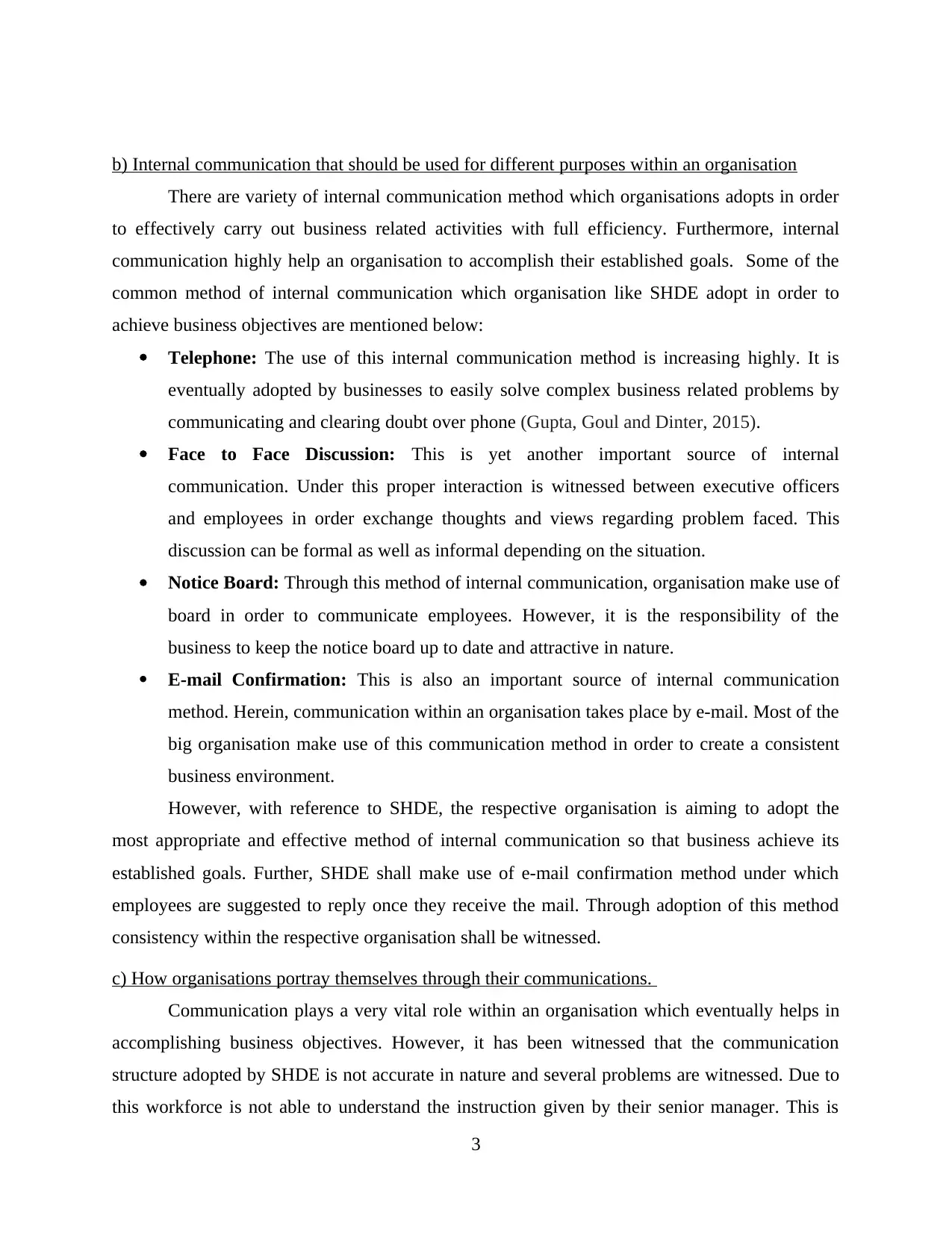
b) Internal communication that should be used for different purposes within an organisation
There are variety of internal communication method which organisations adopts in order
to effectively carry out business related activities with full efficiency. Furthermore, internal
communication highly help an organisation to accomplish their established goals. Some of the
common method of internal communication which organisation like SHDE adopt in order to
achieve business objectives are mentioned below:
Telephone: The use of this internal communication method is increasing highly. It is
eventually adopted by businesses to easily solve complex business related problems by
communicating and clearing doubt over phone (Gupta, Goul and Dinter, 2015).
Face to Face Discussion: This is yet another important source of internal
communication. Under this proper interaction is witnessed between executive officers
and employees in order exchange thoughts and views regarding problem faced. This
discussion can be formal as well as informal depending on the situation.
Notice Board: Through this method of internal communication, organisation make use of
board in order to communicate employees. However, it is the responsibility of the
business to keep the notice board up to date and attractive in nature.
E-mail Confirmation: This is also an important source of internal communication
method. Herein, communication within an organisation takes place by e-mail. Most of the
big organisation make use of this communication method in order to create a consistent
business environment.
However, with reference to SHDE, the respective organisation is aiming to adopt the
most appropriate and effective method of internal communication so that business achieve its
established goals. Further, SHDE shall make use of e-mail confirmation method under which
employees are suggested to reply once they receive the mail. Through adoption of this method
consistency within the respective organisation shall be witnessed.
c) How organisations portray themselves through their communications.
Communication plays a very vital role within an organisation which eventually helps in
accomplishing business objectives. However, it has been witnessed that the communication
structure adopted by SHDE is not accurate in nature and several problems are witnessed. Due to
this workforce is not able to understand the instruction given by their senior manager. This is
3
There are variety of internal communication method which organisations adopts in order
to effectively carry out business related activities with full efficiency. Furthermore, internal
communication highly help an organisation to accomplish their established goals. Some of the
common method of internal communication which organisation like SHDE adopt in order to
achieve business objectives are mentioned below:
Telephone: The use of this internal communication method is increasing highly. It is
eventually adopted by businesses to easily solve complex business related problems by
communicating and clearing doubt over phone (Gupta, Goul and Dinter, 2015).
Face to Face Discussion: This is yet another important source of internal
communication. Under this proper interaction is witnessed between executive officers
and employees in order exchange thoughts and views regarding problem faced. This
discussion can be formal as well as informal depending on the situation.
Notice Board: Through this method of internal communication, organisation make use of
board in order to communicate employees. However, it is the responsibility of the
business to keep the notice board up to date and attractive in nature.
E-mail Confirmation: This is also an important source of internal communication
method. Herein, communication within an organisation takes place by e-mail. Most of the
big organisation make use of this communication method in order to create a consistent
business environment.
However, with reference to SHDE, the respective organisation is aiming to adopt the
most appropriate and effective method of internal communication so that business achieve its
established goals. Further, SHDE shall make use of e-mail confirmation method under which
employees are suggested to reply once they receive the mail. Through adoption of this method
consistency within the respective organisation shall be witnessed.
c) How organisations portray themselves through their communications.
Communication plays a very vital role within an organisation which eventually helps in
accomplishing business objectives. However, it has been witnessed that the communication
structure adopted by SHDE is not accurate in nature and several problems are witnessed. Due to
this workforce is not able to understand the instruction given by their senior manager. This is
3
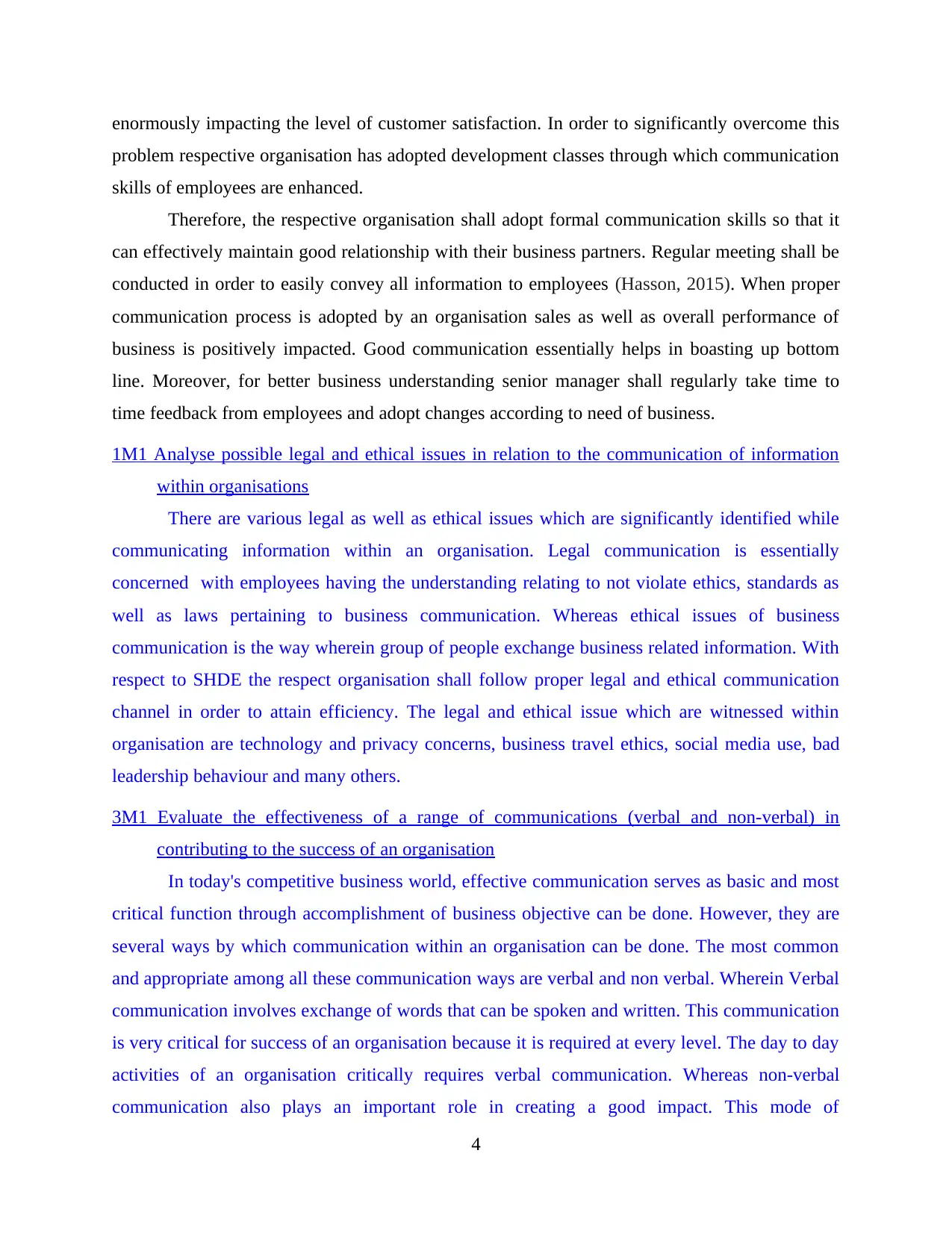
enormously impacting the level of customer satisfaction. In order to significantly overcome this
problem respective organisation has adopted development classes through which communication
skills of employees are enhanced.
Therefore, the respective organisation shall adopt formal communication skills so that it
can effectively maintain good relationship with their business partners. Regular meeting shall be
conducted in order to easily convey all information to employees (Hasson, 2015). When proper
communication process is adopted by an organisation sales as well as overall performance of
business is positively impacted. Good communication essentially helps in boasting up bottom
line. Moreover, for better business understanding senior manager shall regularly take time to
time feedback from employees and adopt changes according to need of business.
1M1 Analyse possible legal and ethical issues in relation to the communication of information
within organisations
There are various legal as well as ethical issues which are significantly identified while
communicating information within an organisation. Legal communication is essentially
concerned with employees having the understanding relating to not violate ethics, standards as
well as laws pertaining to business communication. Whereas ethical issues of business
communication is the way wherein group of people exchange business related information. With
respect to SHDE the respect organisation shall follow proper legal and ethical communication
channel in order to attain efficiency. The legal and ethical issue which are witnessed within
organisation are technology and privacy concerns, business travel ethics, social media use, bad
leadership behaviour and many others.
3M1 Evaluate the effectiveness of a range of communications (verbal and non-verbal) in
contributing to the success of an organisation
In today's competitive business world, effective communication serves as basic and most
critical function through accomplishment of business objective can be done. However, they are
several ways by which communication within an organisation can be done. The most common
and appropriate among all these communication ways are verbal and non verbal. Wherein Verbal
communication involves exchange of words that can be spoken and written. This communication
is very critical for success of an organisation because it is required at every level. The day to day
activities of an organisation critically requires verbal communication. Whereas non-verbal
communication also plays an important role in creating a good impact. This mode of
4
problem respective organisation has adopted development classes through which communication
skills of employees are enhanced.
Therefore, the respective organisation shall adopt formal communication skills so that it
can effectively maintain good relationship with their business partners. Regular meeting shall be
conducted in order to easily convey all information to employees (Hasson, 2015). When proper
communication process is adopted by an organisation sales as well as overall performance of
business is positively impacted. Good communication essentially helps in boasting up bottom
line. Moreover, for better business understanding senior manager shall regularly take time to
time feedback from employees and adopt changes according to need of business.
1M1 Analyse possible legal and ethical issues in relation to the communication of information
within organisations
There are various legal as well as ethical issues which are significantly identified while
communicating information within an organisation. Legal communication is essentially
concerned with employees having the understanding relating to not violate ethics, standards as
well as laws pertaining to business communication. Whereas ethical issues of business
communication is the way wherein group of people exchange business related information. With
respect to SHDE the respect organisation shall follow proper legal and ethical communication
channel in order to attain efficiency. The legal and ethical issue which are witnessed within
organisation are technology and privacy concerns, business travel ethics, social media use, bad
leadership behaviour and many others.
3M1 Evaluate the effectiveness of a range of communications (verbal and non-verbal) in
contributing to the success of an organisation
In today's competitive business world, effective communication serves as basic and most
critical function through accomplishment of business objective can be done. However, they are
several ways by which communication within an organisation can be done. The most common
and appropriate among all these communication ways are verbal and non verbal. Wherein Verbal
communication involves exchange of words that can be spoken and written. This communication
is very critical for success of an organisation because it is required at every level. The day to day
activities of an organisation critically requires verbal communication. Whereas non-verbal
communication also plays an important role in creating a good impact. This mode of
4
⊘ This is a preview!⊘
Do you want full access?
Subscribe today to unlock all pages.

Trusted by 1+ million students worldwide
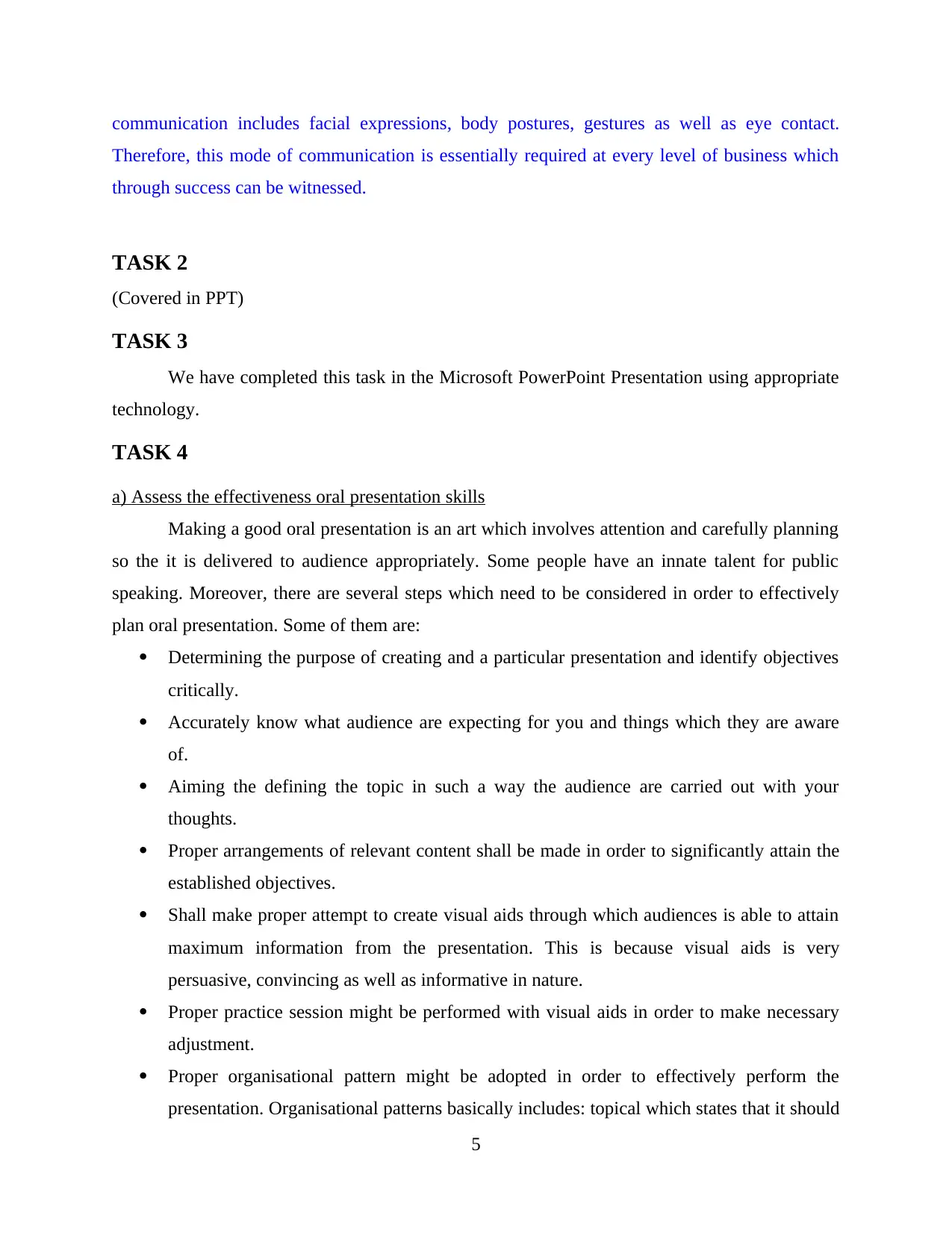
communication includes facial expressions, body postures, gestures as well as eye contact.
Therefore, this mode of communication is essentially required at every level of business which
through success can be witnessed.
TASK 2
(Covered in PPT)
TASK 3
We have completed this task in the Microsoft PowerPoint Presentation using appropriate
technology.
TASK 4
a) Assess the effectiveness oral presentation skills
Making a good oral presentation is an art which involves attention and carefully planning
so the it is delivered to audience appropriately. Some people have an innate talent for public
speaking. Moreover, there are several steps which need to be considered in order to effectively
plan oral presentation. Some of them are:
Determining the purpose of creating and a particular presentation and identify objectives
critically.
Accurately know what audience are expecting for you and things which they are aware
of.
Aiming the defining the topic in such a way the audience are carried out with your
thoughts.
Proper arrangements of relevant content shall be made in order to significantly attain the
established objectives.
Shall make proper attempt to create visual aids through which audiences is able to attain
maximum information from the presentation. This is because visual aids is very
persuasive, convincing as well as informative in nature.
Proper practice session might be performed with visual aids in order to make necessary
adjustment.
Proper organisational pattern might be adopted in order to effectively perform the
presentation. Organisational patterns basically includes: topical which states that it should
5
Therefore, this mode of communication is essentially required at every level of business which
through success can be witnessed.
TASK 2
(Covered in PPT)
TASK 3
We have completed this task in the Microsoft PowerPoint Presentation using appropriate
technology.
TASK 4
a) Assess the effectiveness oral presentation skills
Making a good oral presentation is an art which involves attention and carefully planning
so the it is delivered to audience appropriately. Some people have an innate talent for public
speaking. Moreover, there are several steps which need to be considered in order to effectively
plan oral presentation. Some of them are:
Determining the purpose of creating and a particular presentation and identify objectives
critically.
Accurately know what audience are expecting for you and things which they are aware
of.
Aiming the defining the topic in such a way the audience are carried out with your
thoughts.
Proper arrangements of relevant content shall be made in order to significantly attain the
established objectives.
Shall make proper attempt to create visual aids through which audiences is able to attain
maximum information from the presentation. This is because visual aids is very
persuasive, convincing as well as informative in nature.
Proper practice session might be performed with visual aids in order to make necessary
adjustment.
Proper organisational pattern might be adopted in order to effectively perform the
presentation. Organisational patterns basically includes: topical which states that it should
5
Paraphrase This Document
Need a fresh take? Get an instant paraphrase of this document with our AI Paraphraser
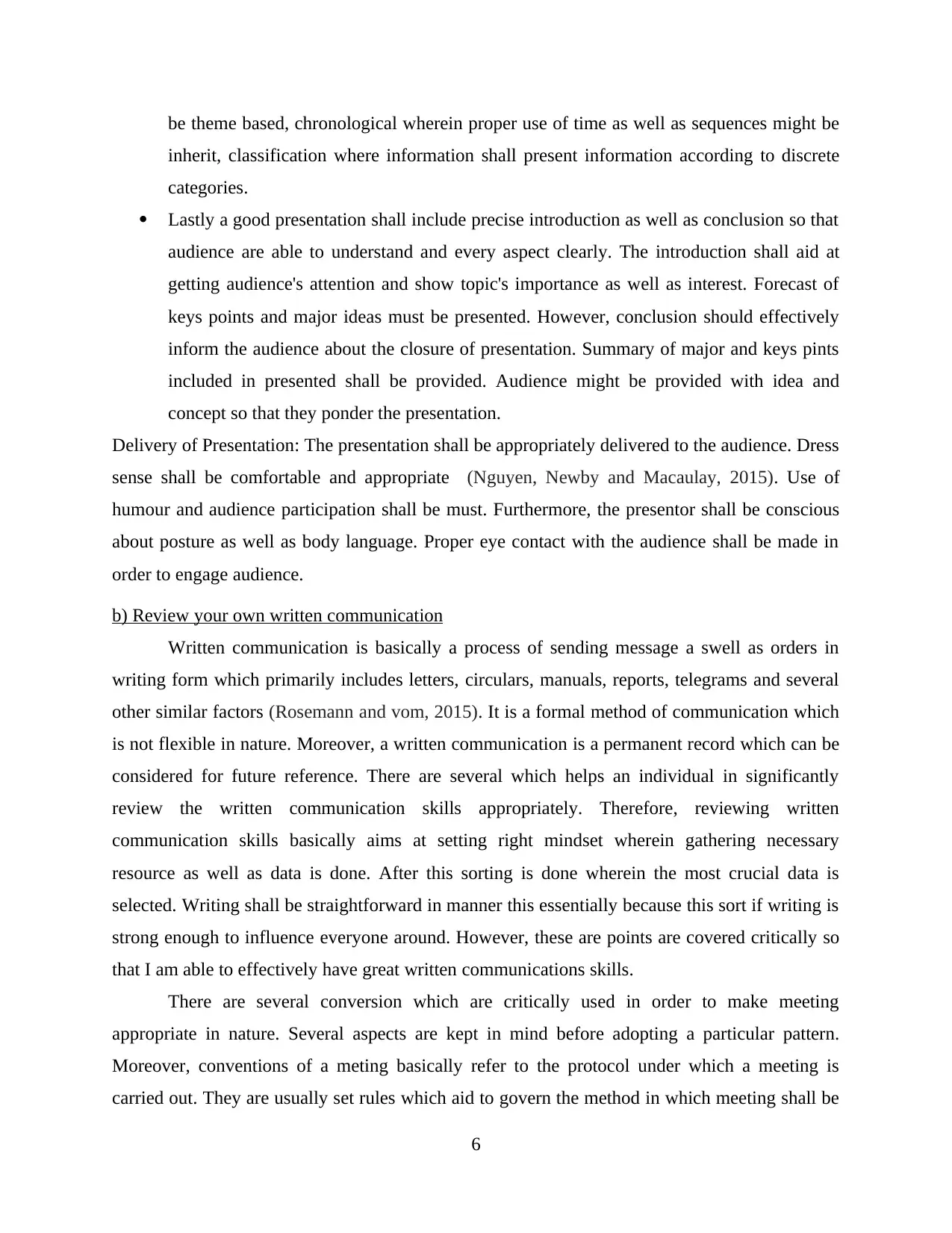
be theme based, chronological wherein proper use of time as well as sequences might be
inherit, classification where information shall present information according to discrete
categories.
Lastly a good presentation shall include precise introduction as well as conclusion so that
audience are able to understand and every aspect clearly. The introduction shall aid at
getting audience's attention and show topic's importance as well as interest. Forecast of
keys points and major ideas must be presented. However, conclusion should effectively
inform the audience about the closure of presentation. Summary of major and keys pints
included in presented shall be provided. Audience might be provided with idea and
concept so that they ponder the presentation.
Delivery of Presentation: The presentation shall be appropriately delivered to the audience. Dress
sense shall be comfortable and appropriate (Nguyen, Newby and Macaulay, 2015). Use of
humour and audience participation shall be must. Furthermore, the presentor shall be conscious
about posture as well as body language. Proper eye contact with the audience shall be made in
order to engage audience.
b) Review your own written communication
Written communication is basically a process of sending message a swell as orders in
writing form which primarily includes letters, circulars, manuals, reports, telegrams and several
other similar factors (Rosemann and vom, 2015). It is a formal method of communication which
is not flexible in nature. Moreover, a written communication is a permanent record which can be
considered for future reference. There are several which helps an individual in significantly
review the written communication skills appropriately. Therefore, reviewing written
communication skills basically aims at setting right mindset wherein gathering necessary
resource as well as data is done. After this sorting is done wherein the most crucial data is
selected. Writing shall be straightforward in manner this essentially because this sort if writing is
strong enough to influence everyone around. However, these are points are covered critically so
that I am able to effectively have great written communications skills.
There are several conversion which are critically used in order to make meeting
appropriate in nature. Several aspects are kept in mind before adopting a particular pattern.
Moreover, conventions of a meting basically refer to the protocol under which a meeting is
carried out. They are usually set rules which aid to govern the method in which meeting shall be
6
inherit, classification where information shall present information according to discrete
categories.
Lastly a good presentation shall include precise introduction as well as conclusion so that
audience are able to understand and every aspect clearly. The introduction shall aid at
getting audience's attention and show topic's importance as well as interest. Forecast of
keys points and major ideas must be presented. However, conclusion should effectively
inform the audience about the closure of presentation. Summary of major and keys pints
included in presented shall be provided. Audience might be provided with idea and
concept so that they ponder the presentation.
Delivery of Presentation: The presentation shall be appropriately delivered to the audience. Dress
sense shall be comfortable and appropriate (Nguyen, Newby and Macaulay, 2015). Use of
humour and audience participation shall be must. Furthermore, the presentor shall be conscious
about posture as well as body language. Proper eye contact with the audience shall be made in
order to engage audience.
b) Review your own written communication
Written communication is basically a process of sending message a swell as orders in
writing form which primarily includes letters, circulars, manuals, reports, telegrams and several
other similar factors (Rosemann and vom, 2015). It is a formal method of communication which
is not flexible in nature. Moreover, a written communication is a permanent record which can be
considered for future reference. There are several which helps an individual in significantly
review the written communication skills appropriately. Therefore, reviewing written
communication skills basically aims at setting right mindset wherein gathering necessary
resource as well as data is done. After this sorting is done wherein the most crucial data is
selected. Writing shall be straightforward in manner this essentially because this sort if writing is
strong enough to influence everyone around. However, these are points are covered critically so
that I am able to effectively have great written communications skills.
There are several conversion which are critically used in order to make meeting
appropriate in nature. Several aspects are kept in mind before adopting a particular pattern.
Moreover, conventions of a meting basically refer to the protocol under which a meeting is
carried out. They are usually set rules which aid to govern the method in which meeting shall be
6
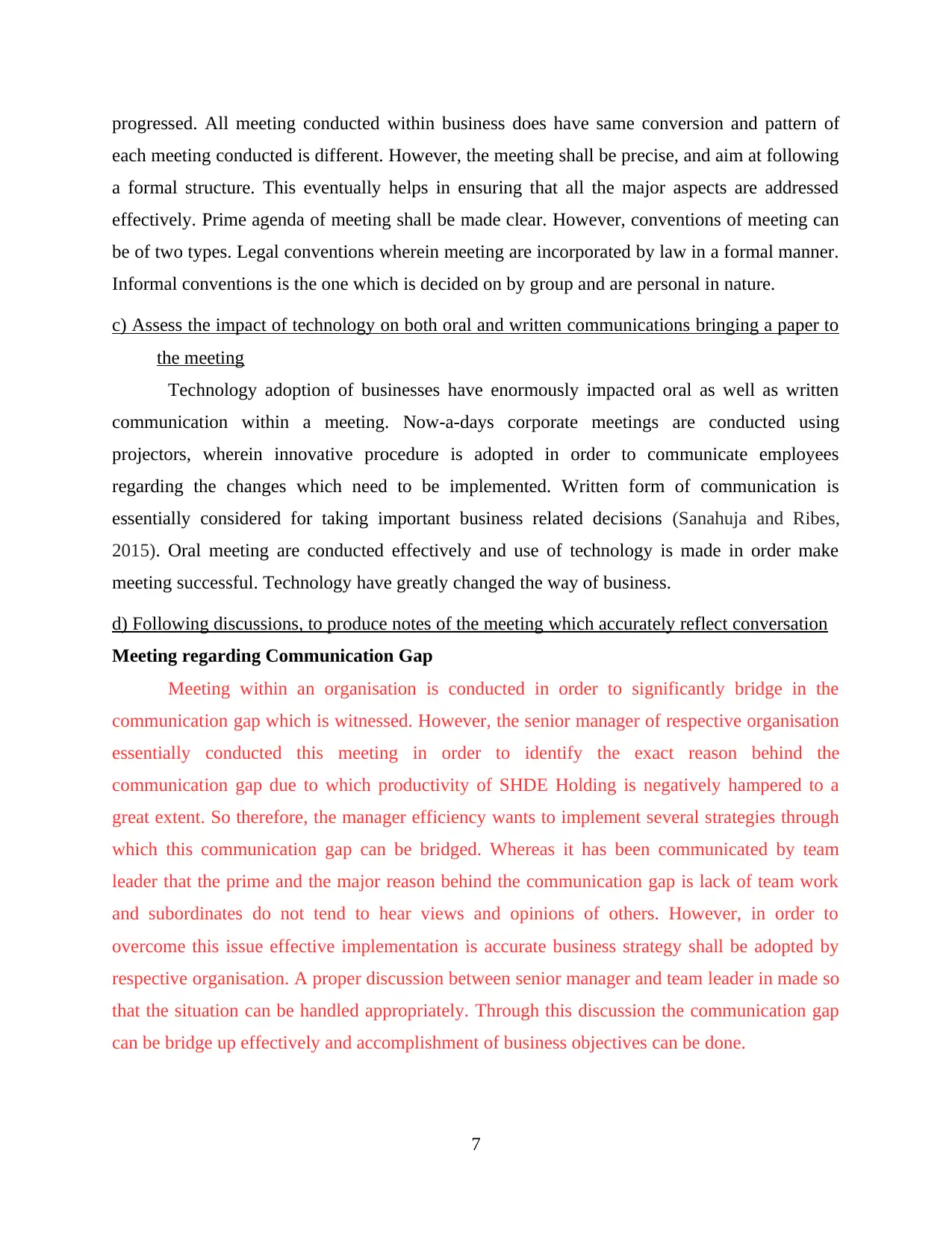
progressed. All meeting conducted within business does have same conversion and pattern of
each meeting conducted is different. However, the meeting shall be precise, and aim at following
a formal structure. This eventually helps in ensuring that all the major aspects are addressed
effectively. Prime agenda of meeting shall be made clear. However, conventions of meeting can
be of two types. Legal conventions wherein meeting are incorporated by law in a formal manner.
Informal conventions is the one which is decided on by group and are personal in nature.
c) Assess the impact of technology on both oral and written communications bringing a paper to
the meeting
Technology adoption of businesses have enormously impacted oral as well as written
communication within a meeting. Now-a-days corporate meetings are conducted using
projectors, wherein innovative procedure is adopted in order to communicate employees
regarding the changes which need to be implemented. Written form of communication is
essentially considered for taking important business related decisions (Sanahuja and Ribes,
2015). Oral meeting are conducted effectively and use of technology is made in order make
meeting successful. Technology have greatly changed the way of business.
d) Following discussions, to produce notes of the meeting which accurately reflect conversation
Meeting regarding Communication Gap
Meeting within an organisation is conducted in order to significantly bridge in the
communication gap which is witnessed. However, the senior manager of respective organisation
essentially conducted this meeting in order to identify the exact reason behind the
communication gap due to which productivity of SHDE Holding is negatively hampered to a
great extent. So therefore, the manager efficiency wants to implement several strategies through
which this communication gap can be bridged. Whereas it has been communicated by team
leader that the prime and the major reason behind the communication gap is lack of team work
and subordinates do not tend to hear views and opinions of others. However, in order to
overcome this issue effective implementation is accurate business strategy shall be adopted by
respective organisation. A proper discussion between senior manager and team leader in made so
that the situation can be handled appropriately. Through this discussion the communication gap
can be bridge up effectively and accomplishment of business objectives can be done.
7
each meeting conducted is different. However, the meeting shall be precise, and aim at following
a formal structure. This eventually helps in ensuring that all the major aspects are addressed
effectively. Prime agenda of meeting shall be made clear. However, conventions of meeting can
be of two types. Legal conventions wherein meeting are incorporated by law in a formal manner.
Informal conventions is the one which is decided on by group and are personal in nature.
c) Assess the impact of technology on both oral and written communications bringing a paper to
the meeting
Technology adoption of businesses have enormously impacted oral as well as written
communication within a meeting. Now-a-days corporate meetings are conducted using
projectors, wherein innovative procedure is adopted in order to communicate employees
regarding the changes which need to be implemented. Written form of communication is
essentially considered for taking important business related decisions (Sanahuja and Ribes,
2015). Oral meeting are conducted effectively and use of technology is made in order make
meeting successful. Technology have greatly changed the way of business.
d) Following discussions, to produce notes of the meeting which accurately reflect conversation
Meeting regarding Communication Gap
Meeting within an organisation is conducted in order to significantly bridge in the
communication gap which is witnessed. However, the senior manager of respective organisation
essentially conducted this meeting in order to identify the exact reason behind the
communication gap due to which productivity of SHDE Holding is negatively hampered to a
great extent. So therefore, the manager efficiency wants to implement several strategies through
which this communication gap can be bridged. Whereas it has been communicated by team
leader that the prime and the major reason behind the communication gap is lack of team work
and subordinates do not tend to hear views and opinions of others. However, in order to
overcome this issue effective implementation is accurate business strategy shall be adopted by
respective organisation. A proper discussion between senior manager and team leader in made so
that the situation can be handled appropriately. Through this discussion the communication gap
can be bridge up effectively and accomplishment of business objectives can be done.
7
⊘ This is a preview!⊘
Do you want full access?
Subscribe today to unlock all pages.

Trusted by 1+ million students worldwide
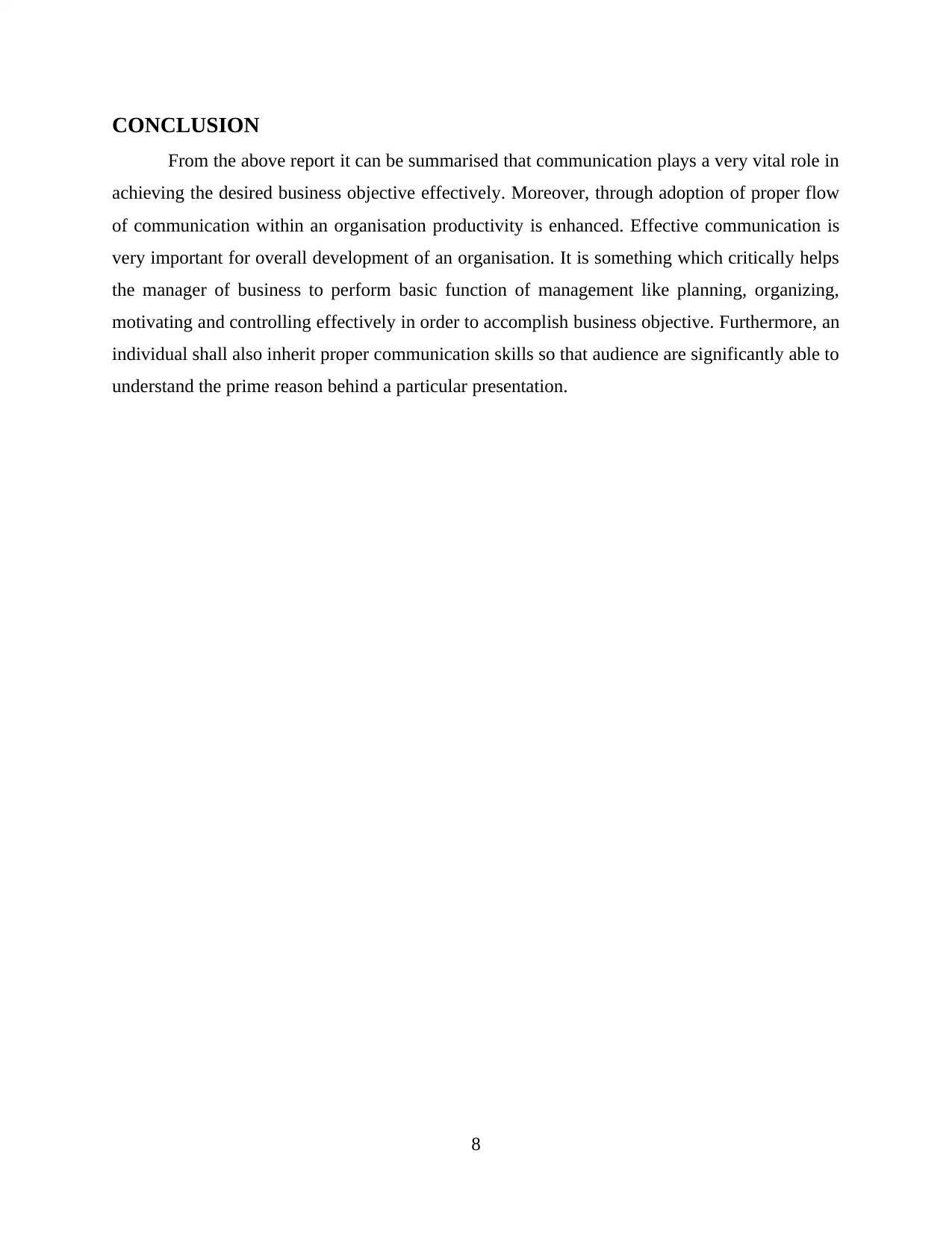
CONCLUSION
From the above report it can be summarised that communication plays a very vital role in
achieving the desired business objective effectively. Moreover, through adoption of proper flow
of communication within an organisation productivity is enhanced. Effective communication is
very important for overall development of an organisation. It is something which critically helps
the manager of business to perform basic function of management like planning, organizing,
motivating and controlling effectively in order to accomplish business objective. Furthermore, an
individual shall also inherit proper communication skills so that audience are significantly able to
understand the prime reason behind a particular presentation.
8
From the above report it can be summarised that communication plays a very vital role in
achieving the desired business objective effectively. Moreover, through adoption of proper flow
of communication within an organisation productivity is enhanced. Effective communication is
very important for overall development of an organisation. It is something which critically helps
the manager of business to perform basic function of management like planning, organizing,
motivating and controlling effectively in order to accomplish business objective. Furthermore, an
individual shall also inherit proper communication skills so that audience are significantly able to
understand the prime reason behind a particular presentation.
8
Paraphrase This Document
Need a fresh take? Get an instant paraphrase of this document with our AI Paraphraser
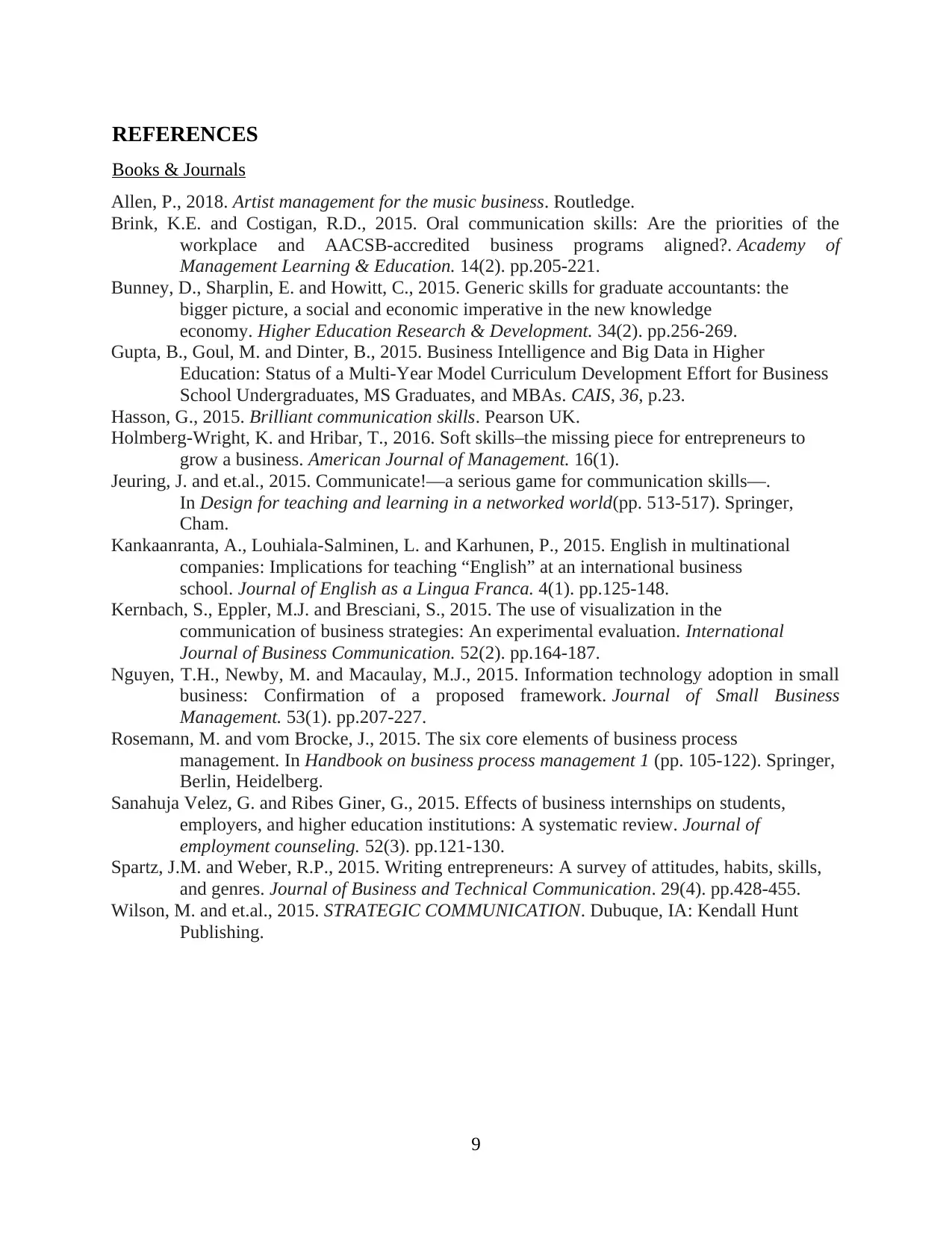
REFERENCES
Books & Journals
Allen, P., 2018. Artist management for the music business. Routledge.
Brink, K.E. and Costigan, R.D., 2015. Oral communication skills: Are the priorities of the
workplace and AACSB-accredited business programs aligned?. Academy of
Management Learning & Education. 14(2). pp.205-221.
Bunney, D., Sharplin, E. and Howitt, C., 2015. Generic skills for graduate accountants: the
bigger picture, a social and economic imperative in the new knowledge
economy. Higher Education Research & Development. 34(2). pp.256-269.
Gupta, B., Goul, M. and Dinter, B., 2015. Business Intelligence and Big Data in Higher
Education: Status of a Multi-Year Model Curriculum Development Effort for Business
School Undergraduates, MS Graduates, and MBAs. CAIS, 36, p.23.
Hasson, G., 2015. Brilliant communication skills. Pearson UK.
Holmberg-Wright, K. and Hribar, T., 2016. Soft skills–the missing piece for entrepreneurs to
grow a business. American Journal of Management. 16(1).
Jeuring, J. and et.al., 2015. Communicate!—a serious game for communication skills—.
In Design for teaching and learning in a networked world(pp. 513-517). Springer,
Cham.
Kankaanranta, A., Louhiala-Salminen, L. and Karhunen, P., 2015. English in multinational
companies: Implications for teaching “English” at an international business
school. Journal of English as a Lingua Franca. 4(1). pp.125-148.
Kernbach, S., Eppler, M.J. and Bresciani, S., 2015. The use of visualization in the
communication of business strategies: An experimental evaluation. International
Journal of Business Communication. 52(2). pp.164-187.
Nguyen, T.H., Newby, M. and Macaulay, M.J., 2015. Information technology adoption in small
business: Confirmation of a proposed framework. Journal of Small Business
Management. 53(1). pp.207-227.
Rosemann, M. and vom Brocke, J., 2015. The six core elements of business process
management. In Handbook on business process management 1 (pp. 105-122). Springer,
Berlin, Heidelberg.
Sanahuja Velez, G. and Ribes Giner, G., 2015. Effects of business internships on students,
employers, and higher education institutions: A systematic review. Journal of
employment counseling. 52(3). pp.121-130.
Spartz, J.M. and Weber, R.P., 2015. Writing entrepreneurs: A survey of attitudes, habits, skills,
and genres. Journal of Business and Technical Communication. 29(4). pp.428-455.
Wilson, M. and et.al., 2015. STRATEGIC COMMUNICATION. Dubuque, IA: Kendall Hunt
Publishing.
9
Books & Journals
Allen, P., 2018. Artist management for the music business. Routledge.
Brink, K.E. and Costigan, R.D., 2015. Oral communication skills: Are the priorities of the
workplace and AACSB-accredited business programs aligned?. Academy of
Management Learning & Education. 14(2). pp.205-221.
Bunney, D., Sharplin, E. and Howitt, C., 2015. Generic skills for graduate accountants: the
bigger picture, a social and economic imperative in the new knowledge
economy. Higher Education Research & Development. 34(2). pp.256-269.
Gupta, B., Goul, M. and Dinter, B., 2015. Business Intelligence and Big Data in Higher
Education: Status of a Multi-Year Model Curriculum Development Effort for Business
School Undergraduates, MS Graduates, and MBAs. CAIS, 36, p.23.
Hasson, G., 2015. Brilliant communication skills. Pearson UK.
Holmberg-Wright, K. and Hribar, T., 2016. Soft skills–the missing piece for entrepreneurs to
grow a business. American Journal of Management. 16(1).
Jeuring, J. and et.al., 2015. Communicate!—a serious game for communication skills—.
In Design for teaching and learning in a networked world(pp. 513-517). Springer,
Cham.
Kankaanranta, A., Louhiala-Salminen, L. and Karhunen, P., 2015. English in multinational
companies: Implications for teaching “English” at an international business
school. Journal of English as a Lingua Franca. 4(1). pp.125-148.
Kernbach, S., Eppler, M.J. and Bresciani, S., 2015. The use of visualization in the
communication of business strategies: An experimental evaluation. International
Journal of Business Communication. 52(2). pp.164-187.
Nguyen, T.H., Newby, M. and Macaulay, M.J., 2015. Information technology adoption in small
business: Confirmation of a proposed framework. Journal of Small Business
Management. 53(1). pp.207-227.
Rosemann, M. and vom Brocke, J., 2015. The six core elements of business process
management. In Handbook on business process management 1 (pp. 105-122). Springer,
Berlin, Heidelberg.
Sanahuja Velez, G. and Ribes Giner, G., 2015. Effects of business internships on students,
employers, and higher education institutions: A systematic review. Journal of
employment counseling. 52(3). pp.121-130.
Spartz, J.M. and Weber, R.P., 2015. Writing entrepreneurs: A survey of attitudes, habits, skills,
and genres. Journal of Business and Technical Communication. 29(4). pp.428-455.
Wilson, M. and et.al., 2015. STRATEGIC COMMUNICATION. Dubuque, IA: Kendall Hunt
Publishing.
9
1 out of 11
Related Documents
Your All-in-One AI-Powered Toolkit for Academic Success.
+13062052269
info@desklib.com
Available 24*7 on WhatsApp / Email
![[object Object]](/_next/static/media/star-bottom.7253800d.svg)
Unlock your academic potential
Copyright © 2020–2025 A2Z Services. All Rights Reserved. Developed and managed by ZUCOL.





